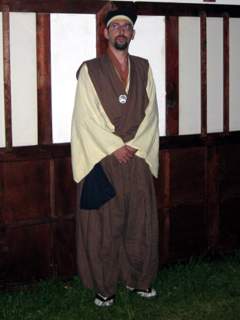More Japanese Garb
Cream Kosode, Brown Kataginu Kamishimo, and Cream Kyahan

April 2008

April 2008
I figure if I make one new outfit a year, I'll outpace stuff wearing out and have plenty of Japanese garb to wear. I had some cream-colored soft linen, and some regular brown linen, so I made this outfit and wore it to our Clan Dinner. When you have a top and bottom that go together, this is refered to as a kamishimo. This particular kamishimo pairs hakama with a sleeveless and sideless vest called a kataginu, so it is referred to as kataginu kamishimo. I made a kataginu kamishimo out of a blue striped linen a few years ago, and it was very well received, so I thought I'd add another to my wardrobe. At the very least it adds another pair of hakama, and the kataginu make the enesemble significantly more formal. Later kataginu, like the ones you see in most samurai movies, are pleated to thin strips in the front and sometimes have bi winglike shoulders. Older kataginu are very rectangular.
Anyway, in the picture above I'm wearing:
I'm standing in front of Saiaiko's Buke Yashiki, a wonderful project that makes our camp look terrific.
 |
Cream colored soft linen I bought at Pennsic. It's made with "cut fibers", so it's super soft. |  |
Medium brown linen I bought at JoAnn Fabrics. This is more like the linen you expect to get, slightly stiff. |  |
Some light brown linen fabric. I'm not sure where it came from, or if it is even 100% linen. |
 |
This black linen is also from JoAnn. Its texture is different than the brown linen though, a bit thicker and rougher. |  |
Indigo cotton fabric from Kona Bay, with a light print simulating a yarn-dyed pattern. |
The kosode was made using my standard kosode process, though the sleeves are two panels "long".
The hakama was made using my standard process for six-panel (three panels per leg) hakama.
The kataginu is two panels wide, and comes down from my shoulders about a yard and a half. It's fitted to the width of my shoulders, with the excess fabric turned under and tacked using a hemming stitch.
The kyahan were made using my rectangular method again instead of the trapezoidal method most people like. They're actually a bit small since they're made from leftovers, but since I didn't put drawstrings in the hakama legs, you can't even see them unless I'm walking.

As part of this batch of garb sewing, I also made another pair of monpe . (Previous monpe: brown stripe monpe, natural linen monpe.) This pair is made with a soft linen that is mostly white, but has thin black stripes. I only bought enough of it to do the leg panels themselves, so I used some plain black linen for the waist ties, and some plain white linen for the leg ties.
I did the leg ties a little differently on this pair. Instead of cords through a casing, I gathered the fabric a bit and then sewed it into the ties in the same way that the waist is sewn into the waist ties. This looks a little better, especially when tied, but isn't as practical and is much more difficult to do. I don't think I'll do it again this way.